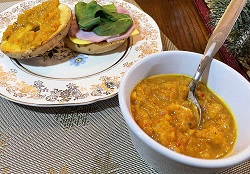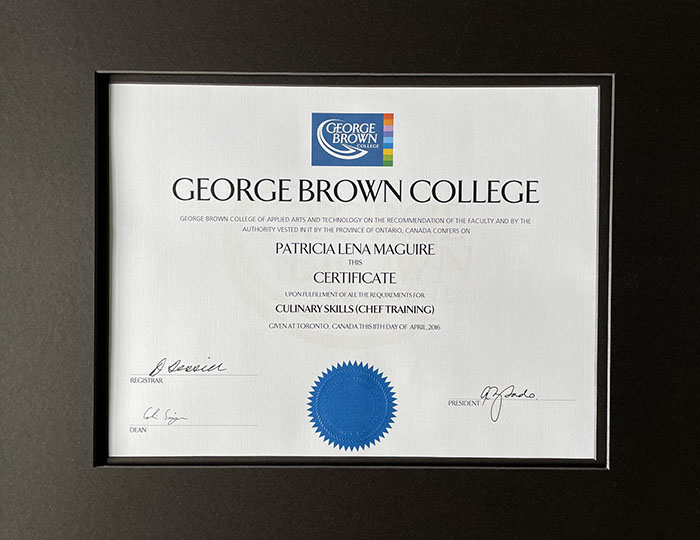- Home
- Gluten Free Cooking
- Homemade Gluten-Free Sauces
Homemade Gluten-Free Sauces
12 Gluten-Free Sauce Recipes for Every Occasion
Making your own homemade gluten-free sauces can be really easy, or a bit tricky. I'm here to take the mystery out of sauce making and give you a few simple steps and easy recipes so you'll have the confidence to make your own gluten-free sauces.

Skip right to the section that interests you, or scroll through and you'll be a homemade gluten-free sauce expert when you get to the bottom.
The Three Sauces You'll Use Over and Over
- White Sauce
- Brown Sauce
- Cream Sauce and Cheese Sauce
- Tomato Sauce
- Apple Sauce
- Vegetable Purees
Simple Sauces From Items in Your Pantry or Fridge
- Gluten-Free Pan Gravy
- Simple Aioli for Fish
- Easy Seafood Sauce
What is a Sauce?
A sauce is a thickened liquid that we add to our food to improve the texture, add moisture, and to enhance the flavor. Without sauce our food would be just a little blander and a little drier and who wants that? We deserve to enjoy our food.
Gluten In Sauces
Five Ingredients to Watch For:
- flour
- barley malt
- malt vinegar
- Worcestershire
- Soy Sauce
Eliminate these or use gluten-free alternatives.
You already know what foods are gluten-free. The best choices are the ones that are naturally gluten-free like fruits, vegetables, fresh cuts of meat and fresh dairy and eggs. It’s when we go to dress up those things with a sauce that we run into trouble. That’s because many sauces are either thickened with flour or they contain an ingredient that has gluten. If you can eliminate those ingredients then you have a gluten-free sauce.
Sauce Basics
A gluten free sauce, in fact any sauce has just two main components:
- A liquid
- A thickener
That's it. Simple right? Let's take it a but further.
Liquid for Homemade Gluten-Free Sauces
Liquids that make up most sauces are:
- Stock like chicken, beef, vegetable, turkey or veal. Just make sure you use gluten-free stock.
- Milk or cream. This includes plant based milks like coconut milk, rice milk, almond milk etc. These are naturally gluten-free, but check labels anyway.
- Pureed vegetables or fruit like tomatoes, peppers, potatoes, squash, apples, pears etc., these are also naturally gluten-free.
52 Things You Need In Your Gluten-Free Pantry: Living gluten-free requires some products you've maybe not bought before. These are the gluten-free staples that you'll want to stock up on.
Thickening Sauces
There are just a few ways to thicken a sauce. These may be used on their own or in combination:
- Flour - A mixture of equal parts flour and fat is called a "roux". This is the base for most thickened sauces. We'll of course use gluten-free flour.
- Starch like cornstarch or tapioca starch - These are naturally gluten-free. Just make sure they are not contaminated by wheat flour.
- Puree - We included pureed fruits and vegetables among the liquids for sauces and they tend to already be a bit thick. This may be all that's needed or purees can be added to sauces as thickeners. A pureed sauce may be "reduced" to increase thickness and flavor.
- Reduction - This is more of a technique than an ingredient. It just means simmering your sauce on medium low heat so some of the water evaporates and your sauce is thicker and richer.
- Emulsifying - Think of a salad dressing. If you shake up a bottle of oil and vinegar it will thicken. It won't stay that way, but there are ways to make it hold longer. Mayonnaise is an emulsification of eggs and vinegar and oil.
You can use pureed potatoes as a thickener like in this Gluten Free Hotpot with Chocolate and Cider. It combines the starch and puree methods for a naturally gluten free thickener.
Keto Friendly Sauces
If you're on a keto diet, you're avoiding flours and starches. That's okay. You can still make your favorite gluten-free sauces just by using the right thickening technique.
Purees, reduction and emulsifying are keto friendly methods of thickening your sauces. In the case of purees, just make sure you are using keto friendly vegetables.
To replace flour or starches, you can use xanthan gum or guar gum. Both are much stronger thickeners than flour and starch so start with a very little bit then add more if needed.
To replace one tbsp of cornstarch, start with 1/8 tsp of xanthan or guar gum. Sprinkle it over your sauce then whisk to combine. Add more if needed.
You can make a roux with xanthan gum and guar gum similar to how your would with flour but with much less. To replace 3 tbsp of flour in your roux, start with 1/2 tsp of xanthan or guar gum. If the sauce isn't thick enough whisk in a bit more.
Flour For Homemade Gluten-Free Sauce
Unlike for baking, you don’t need a combination of different flours to thicken a sauce. If you have a gluten-free all purpose flour blend in your pantry that’s perfect, or you can just use rice flour or any other gluten-free flour.
 Photo by Vlad Kutepov on Unsplash
Photo by Vlad Kutepov on UnsplashFlavoring For Homemade Gluten-Free Sauce

There is no limit to what you can use to flavor a sauce.
Herbs and spices are the most common, and depending on the cuisine, different herbs and spices will play a lead role. A common combination in European cooking is bay leaf, thyme, peppercorns and maybe some parsley and a clove of garlic. This can all be tied up in a little cheese cloth bag to make them easy to remove later.
Other common flavorings are: chilis for heat, spices, other prepared sauces like gluten-free soya sauce or gluten-free Worcestershire or hot sauces.
Lemon juice or vinegar can give your sauce a nice acidic snap.
Some sauces will start with an "aromatic roux" which is the flour and fat mixture mentioned above, but with onion, celery and maybe a bit of carrot cooked in the fat to add flavor.
The Three Sauces You'll Make Over and Over
Gluten Free White Sauce or Veloute
This is a sauce you'll make over and over. It's great on chicken or fish. It will be the base for your chicken and dumplings, or chicken pot pie.
Liqiud: White stock like chicken, turkey, vegetable or veal
Thickener: Gluten-free flour
Flavoring: Salt and pepper, herbs and spices. Let’s keep it simple and use a bay leaf and a few sprigs of fresh thyme and some parsley. You can use dried or ground thyme if you like.
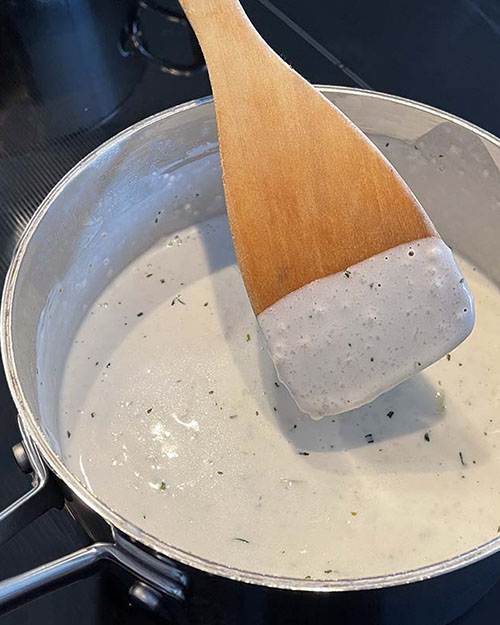
Gluten-Free Chicken Pie: This recipe uses a rich, smooth gluten-free white sauce, or veloute and is a delicious way to use up leftover chicken and mashed potatoes.
Gluten Free Brown Sauce
This sauce is amazing with red meat. This is what you'll serve with your roast beef; it's the base for your beef stew, and if you pour the leftover brown sauce over French fries and cheese curd you have poutine!
Liquid: Brown stock
Thickener: Gluten-Free flour
Flavoring: Salt and pepper, herbs and spices. Let’s use the same as the white sauce: a bay leaf and a few sprigs of fresh thyme and parsley, and we'll enhance the flavor by starting with an aromatic roux.

Gluten Free Bechamel
This is a creamy milk based sauce. You can use it to top a grilled chicken breast or add cheese and pour it over steamed cauliflower. It's the base for my creamy cheesy gluten-free mac and cheese. For a gluten-free dairy free béchamel or a gluten-free vegan béchamel just substitute a creamy plant based milk like coconut or oat milk.
Liquid: Milk. You can use plant based milk
Thickener: Gluten Free Flour
Flavoring: Salt and pepper
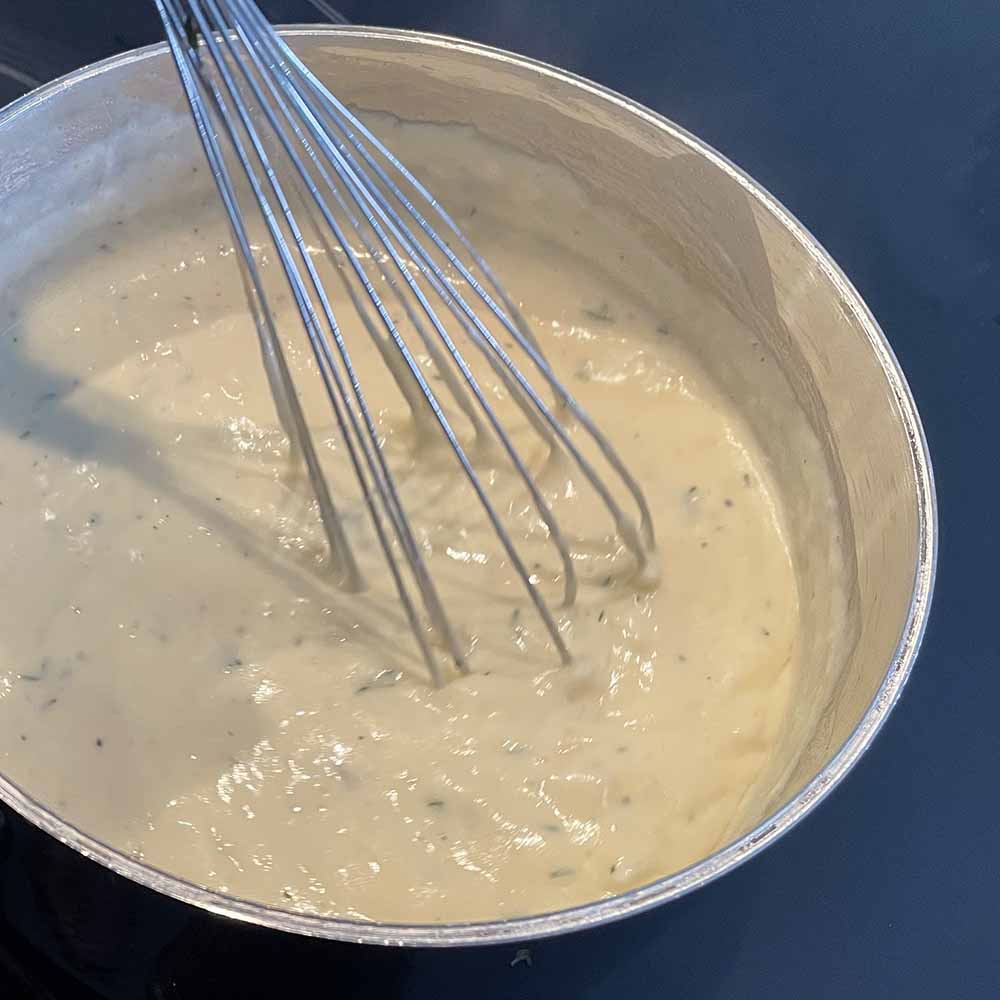
Easy, Creamy Gluten-Free Mac and Cheese: Start with a creamy gluten-free béchamel sauce and end up with the best mac and cheese you've ever tasted.
Gluten-Free Fettuccine Alfredo: This classic Italian pasta dish will have you dreaming you're at your favorite Italian restaurant. Alfredo is a simple flour free white sauce which makes it naturally gluten-free.

The Six Steps to Making a Flour Based Sauce
The steps for making all three of these base sauces is exactly the same. If you know one, you know them all!
Step 1: Heat your fat in the bottom of a saucepan. You can use butter or your favorite cooking oil.
Step 2: Add flour and stir until combined. This is called a roux. Cook it for a couple of minutes. For a white sauce be careful not to let your roux brown. For a brown sauce you can let it brown a bit. Add your onion, carrot and celery here if you're using these. Add spices here if using. Save salt and pepper until the end.
Step 3: Whisk in stock a little bit at a time so it doesn’t go lumpy.
Step 4: Add your herbs here if using.
Step 5: Simmer for 30 min or so uncovered so the sauce will reduce a bit and take on the flavor of the herbs.
Step 6: Season with a bit of salt and pepper.
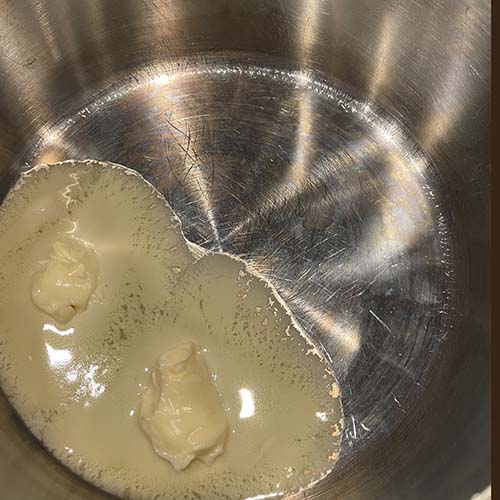
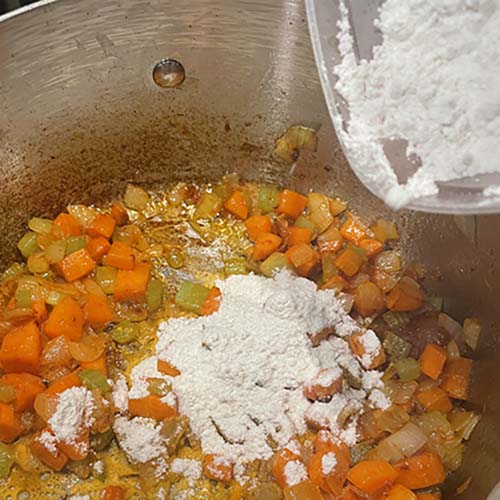

Pureed Sauces
Pureed sauces at their most simple, involve a cooked fruit or vegetable a blender and some seasoning. Here are some examples:
Tomato Sauce
The most common pureed sauce is tomato. The ingredients are:
Tomatoes
Garlic
Salt and sugar
Basil
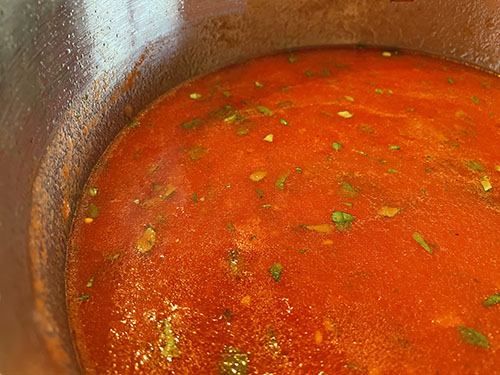
Gluten-Free Roasted Cherry Tomato Sauce: What a wonderful and simple way to use up the fall harvest of cherry tomatoes, or to pretend it's fall in the winter.
Apple Sauce
This is a great way to use up apples that are at risk of going bad. Ingredients are:
Apples - Yes, the simplest apple sauce is just cooked apples.
Sugar
Cinnamon or nutmeg.
If your apples are a little sour, add sugar to taste. A little cinnamon is nice or nutmeg.
Vegetable Purees
Often in fancy restaurants they’ll embellish a plate with a vegetable puree like a bright green pea puree or a beautiful orange sweet potato or butternut squash puree. I think you can guess how those are made.
Vegetable of choice
A little white stock or water to thin it out if necessary
Flavoring like garlic, salt, pepper herbs
You may have noticed pureed soups are made the same way
Easy Gluten-Free Brown Gravy
This is an easy way to make a sauce from the bits left in the pan after you fry your meat. Simply brown the meat on both sides. Remove it from the pan. Add a diced onion to the pan and stir it around to pick up the brown bits. Add a little wine to the pan to get the rest of the bits up from the bottom. This is called “deglazing” your pan. Add your liquid: stock or juice or milk. Put the meat back in and let it all simmer until done. You can also finish it off in the oven if you like.
Gluten-Free Braised Honey Garlic Sausages: Beautifully browned and simmered in a rich mushroom pan gravy. It's so easy and so delicious.
Simple Homemade Gluten-Free Sauces From Items You Have in Your Pantry
Simple Aioli for Fish:
Mix together:
1/2 c
mayonnaise
2 cloves
garlic minced
2 teaspoons lemon juice
2 teaspoons Dijon mustard
1/2 teaspoon tsp
dried tarragon or dill

Ridiculously Simple Seafood Sauce:
Mix together: mayonnaise, ketchup, horseradish to taste.
Tips and Tricks
1. To check the thickness of your gluten free sauce, dip your spoon in. This works best with a wooden spoon. The sauce should coat the back of the spoon but you should still be able to see the wood grain. Now run your finger through the sauce on the back of the spoon. The track should stay but slowly start to run back together.
2. A little trick for thickening up your gluten free sauce just before serving that came out a little too thin is to make a “beurre manier”. Just make a paste that’s half and half flour and butter, a couple of teaspoons of each is usually plenty. Then add pea sized pieces to your sauce. Give each a minute to cook before adding more, until your sauce is the right thickness.
3. Put your spices in a little cheese cloth bag tied up with some string. This way you can easily take them out of the sauce when it's done'
3. Don't add salt and pepper until the end. As your gluten free sauce reduces the flavours will concentrate and it could end up too salty or peppery.
More Gluten-Free Sauce Recipes
Gluten-Free Teriyaki Sauce Recipe: I'm actually happy I never found a store bought teriyaki I like because this homemade version is sooo amazing. Freezes well too!
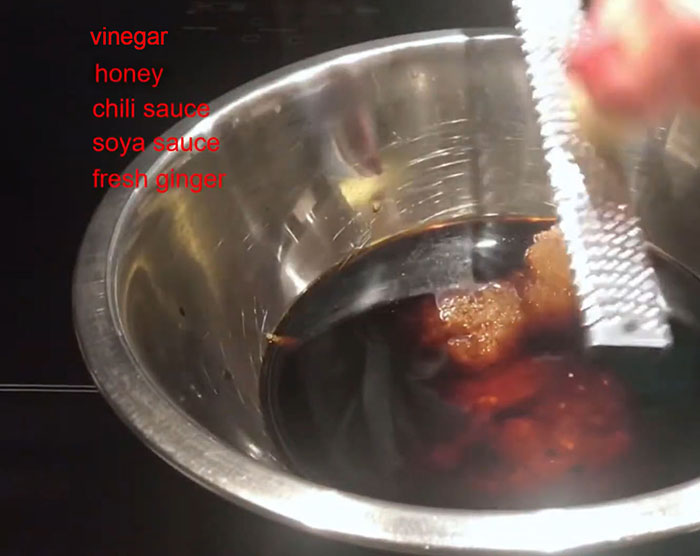
Gluten-Free Honey Garlic Sauce
Coming soon
Curry Pineapple Relish: You'll make it with the intent to share, but will you? It's a great gift, but I gave a couple of my first batch away and then I ran out so quickly I had to make more.
Home > Gluten-Free Cooking > Homemade Gluten-Free Sauces





